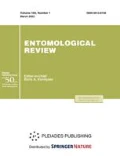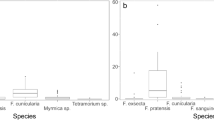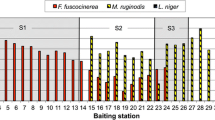Abstract
This work describes the transformation of the nest complex of a facultatively dominant species, Formica cunicularia, which was naturally colonized by the families of obligate dominants, Formica pratensis and Lasius fuliginosus. The complex was under observation from 2003 to 2013. During this period, F. pratensis families almost completely replaced F. cunicularia in the tenth part of the territory of this multispecies association. The family L. fuliginosus did not exert such an effect on the settlement of the facultative dominant. The study addresses the interaction of foragers of the species that found themselves in the zone of F. pratensis invasion, the dynamics of expansion of the dominant’s foraging areas, and the changes in the multispecies formicary association on the whole. It is shown that, even with different peaceful coexistence mechanisms at work, the alteration of the association occurs through attacks of the obligate dominant on the neighboring families. The progress of this process and possible key situations are considered.
Similar content being viewed by others
References
Burgov, E.V., “The Preferences of Some Species of Formica s. str. and Serviformica (Hymenoptera: Formicidae) When Choosing a Substrate for Movement,” in The V All-Russia Conference on Animal Behavior. Book of Abstracts (KMK, Moscow, 2012), p. 22.
Carroll, J.F., “Worker Size and Piracy in Foraging Ants,” Proceedings of the Entomological Society of Washington 90 (90), 495–500 (1988).
Demchenko, A.V., “Multispecies Associations of Formicaries in the Spruce Forests of Moscow Region,” in Ants and Forest Protection. Proceedings of the V All- Union Myrmecological Symposium (Moscow, 1975), pp. 77–82.
Demchenko, A.V., “The Consequences of the Invasion of a New Dominant into a Multispecies Association of Formicaries,” Zool. Zh. 58 (58), 370–377 (1979).
Dlussky, G.M., Ants of the Deserts (Nauka, Moscow, 1981), 230 p. [in Russian].
Kaczmarek, W., “Badania nad Zespolami Mrowek Lesnych,” Ecologia Polska 1, 69–96 (1953).
Reznikova, Zh.I., “The Forms of Territorial Organization in the Meadow Ant Formica pratensis Rets (Hym., Formicidae),” Zool. Zh. 58 (58), 1490–1499 (1979).
Reznikova, Zh.I., “The Structure of the Foraging Area and the System of Foraging in the Meadow Ant Formica pratensis Rets.,” in Ethological Problems of the Ecology of Insects of Siberia (Nauka, Novosibirsk, 1977), pp. 47–59.
Reznikova, Zh.I., Interspecific Relationships in Ants (Nauka, Novosibirsk, 1983) [in Russian].
Seima, F.A., “Some Regularities in the Spatial Distribution of Worker Ants in Biocenoses,” Zool. Zh. 51 (51), 1322–1328 (1972).
Seima, F.A., “The Levels of Organization and Regulatory Systems in the Taiga Associations of Ants,” Uspekhi Sovremennoi Biologii 118 (118), 265–282 (1998).
Seima, F.A., “The Seasonal Dynamics of Monodominant Associations of Ants,” Uspekhi Sovremennoi Biologii 123 (123), 267–272 (2003).
Zakharov, A.A. and Goryunov, D.N., “General Methods for Field Ecological Studies,” in Ants and Forest Protection. Proceedings of the XIII All-Russia Myrmecological Symposium (Nizhny Novgorod, 2009), pp. 247–256.
Zakharov, A.A., “Adaptation of the Ant Family to the Environmental Conditions,” in Adaptation of Soil Animals to the Environmental Conditions (Nauka, Moscow, 1977), pp. 61–81 [in Russian].
Zakharov, A.A., “Dominance Systems in Zonal Multispecies Communities,” Russian Entomol. J. 11 (11), 49–56 (2002).
Author information
Authors and Affiliations
Corresponding author
Additional information
Original Russian Text © E.V. Burgov, 2015, published in Zoologicheskii Zhurnal, 2015, Vol. 94, No. 10, pp. 1200–1210.
Rights and permissions
About this article
Cite this article
Burgov, E.V. The multispecies formicary association: the transition from an incomplete to a complete association. Entmol. Rev. 95, 1010–1020 (2015). https://doi.org/10.1134/S0013873815080084
Received:
Published:
Issue Date:
DOI: https://doi.org/10.1134/S0013873815080084




